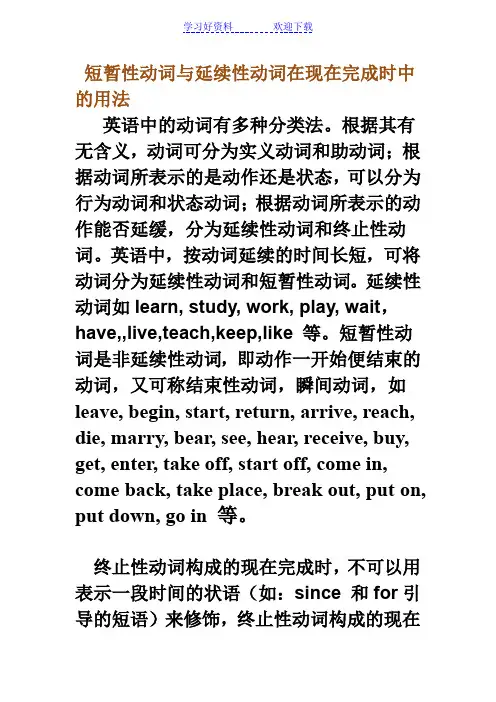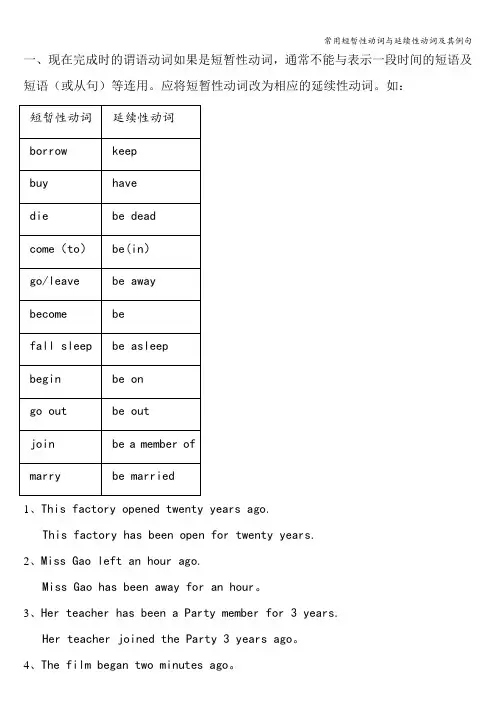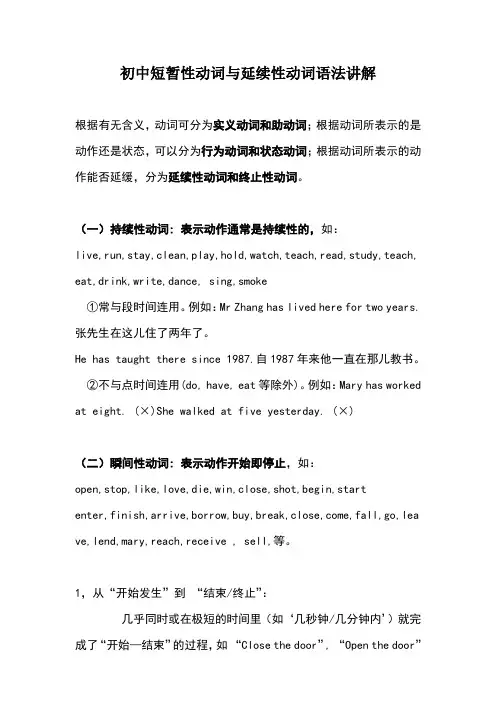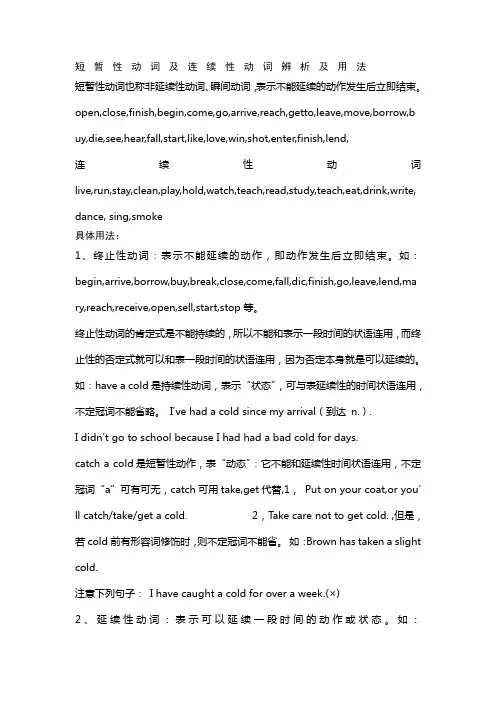延续性动词与短暂性动词的用法
- 格式:doc
- 大小:19.00 KB
- 文档页数:2

短暂性动词与延续性动词在现在完成时中的用法英语中的动词有多种分类法。
根据其有无含义,动词可分为实义动词和助动词;根据动词所表示的是动作还是状态,可以分为行为动词和状态动词;根据动词所表示的动作能否延缓,分为延续性动词和终止性动词。
英语中,按动词延续的时间长短,可将动词分为延续性动词和短暂性动词。
延续性动词如learn, study, work, play, wait,have,,live,teach,keep,like 等。
短暂性动词是非延续性动词,即动作一开始便结束的动词,又可称结束性动词,瞬间动词,如leave, begin, start, return, arrive, reach, die, marry, bear, see, hear, receive, buy, get, enter, take off, start off, come in, come back, take place, break out, put on, put down, go in 等。
终止性动词构成的现在完成时,不可以用表示一段时间的状语(如:since 和for引导的短语)来修饰,终止性动词构成的现在完成时,只表示动作发生的因果关系,不能表示动作的延续,因此不能用表示一段时间的状语来修饰。
如可以说:The Red Cross has already started for the earthquake-stricken area.但不可说:The Red Cross has already started for the earthquake-stricken area for three days.因为start是终止性动词, 它所表示的动作短促, 当红十字会出发时,start这个动作便结束了, 不可能延续两天。
1. 用ago时间状语短语来代替since或for引导的时间状语:eg. Mr. Richard has returned from America for two years. (wrong) Mr. Richard has returned from America since two years ago. (wrong) 应改为: He returned from America two years ago.2.用It is… since…复合句代替简单句eg. It has been/is two years since Mr. Richard returned from America.注意:以上两种办法适用于所有终止性动词。

初中英语中短暂性动词与延续性动词的用法英语中,按动词延续的时间长短,可将动词分为延续性动词和短暂性动词。
延续性动词如learn, study, work, play, wait等。
短暂性动词是非延续性动词,即动作一开始便结束的动词,又可称结束性动词,瞬间动词,如come, go, begin, start, become, join, end, die, buy, arrive,reach, borrow, lend, get to know等。
一.短暂性动词与延续性动词在现在完成时中的用法:现在完成时中用法(一):表示发生在过去,迄今已经完成,并对现在产生影响或产生结果的动作,常用ever, yet, already, just等状语,谓语动词既不过延续性动词,也不过短暂性动词。
如:She has just borrowed the book from the library.(borrow是短暂性动词)I have learned a little about Japanese. (learn 是延续性动词)现在完成时中用法(二):表示始于过去某时并一直延续到现在的动作或状态,常与表示始于过去某一时刻并一直延续到现在的时间状语连用。
如:They have lived in Nantong since 1990. (live 是延续性动词)Mr. Black has worked here since he came to China.(work 是延续性动词)I have learned English for two and a half years.(learn 是延续性动词)所以,在现在完成时中用法(二)中,在表示持续一段时间的句子中,应将短暂性动词转化为相同意义的延续性动词或状态动词。
初中英语中常见的有:例如:1. His grandfather has died for ten years.(F)His grandfather has been dead for ten years.(T) 2. My brother has joined the army for five years.(F)My brother has been in the army for five years.(T) My brother has been an armyman for ten years.(F)3. He has gone away for a week.(F) He has been away for a week.(T)4. The film has begun for fifteen minutes.(F)The film has been on for fifteen minutes.(T)但是,短暂性动词的现在完成时的否定形式能够表示一种延续的状态,所以能够和表示一段的状语连用。

一、现在完成时的谓语动词如果是短暂性动词,通常不能与表示一段时间的短语及短语(或从句)等连用。
应将短暂性动词改为相应的延续性动词。
如:1、This factory opened twenty years ago.This factory has been open for twenty years.2、Miss Gao left an hour ago.Miss Gao has been away for an hour。
3、Her teacher has been a Party member for 3 years.Her teacher joined the Party 3 years ago。
4、The film began two minutes ago。
The film has been on since two minutes ago。
5、He bought the bike two years ago.He has had the bike for two years。
6、The old man died ten years ago.The old man has been dead for ten years.7、He came back 3 days ago.He has been back for 3 days。
8、I left my hometown 10 years ago.I have been away from my hometown for 10 years.9、They got married 13 year ago.They have been married for 13 years。
10、I borrowed the book a week ago。
I have kept the book for a week.How long have you kept the book?注:在否定句中,短暂性动词可以和表示一段时间的状语连用。


短暂性动词与延续性动词语法讲解初中短暂性动词与延续性动词语法讲解根据有无含义,动词可分为实义动词和助动词;根据动词所表示的是动作还是状态,可以分为行为动词和状态动词;根据动词所表示的动作能否延缓,分为延续性动词和终止性动词。
(一)持续性动词: 表示动作通常是持续性的,如:live,run,stay,clean,play,hold,watch,teach,read,study,teach,eat,drink,write, dance, sing,smoke①常与段时间连用。
例如:Mr Zhang has lived here for two years.张先生在这儿住了两年了。
He has taught there since 1987.自1987年来他一直在那儿教书。
②不与点时间连用(do, have, eat等除外)。
例如:Mary has worked at eight. (×)She walked at five yesterday. (×)(二)瞬间性动词: 表示动作开始即停止,如:open,stop,like,love,die,win,close,shot,begin,startenter,finish,arrive,borrow,buy,break,close,come,fall,go,leave,lend,mary,r each,receive , sell,等。
1,从“开始发生”到“结束/终止”:几乎同时或在极短的时间里(如‘几秒钟/几分钟内’)就完成了“开始—结束”的过程,如“Close the door”, “Open the door”2,有些瞬间动词的“开始—结束的过程”可能稍微长一些,但也不会很长的,如,“buy sth(买下)”:付了款、拿了发票即完成了。
所以,“我买了这块手表5年了”,在汉语中说的通,但英语的表达就不能说:I have bought the watch for five years.buy sth ---- have sth (拥有)---have/has + had sth for…A: I have had the watch for 5 years.B: It is (has been) five years since I bought the watch.C: I bought it 5 years ago.同理,“borrow sth”“借书”在办理了相关的‘登记’手续后就结束了,不可能“借”几个星期或好几年的!汉语“这本书我已经借用了2星期了。


初中短暂性动词与延续性动词语法讲解根据有无含义,动词可分为实义动词和助动词;根据动词所表示的是动作还是状态,可以分为行为动词和状态动词;根据动词所表示的动作能否延缓,分为延续性动词和终止性动词。
(一)持续性动词: 表示动作通常是持续性的,如:live,run,stay,clean,play,hold,watch,teach,read,study,teach, eat,drink,write,dance, sing,smoke①常与段时间连用。
例如:Mr Zhang has lived here for two years.张先生在这儿住了两年了。
He has taught there since 1987.自1987年来他一直在那儿教书。
②不与点时间连用(do, have, eat等除外)。
例如:Mary has worked at eight. (×)She walked at five yesterday. (×)(二)瞬间性动词: 表示动作开始即停止,如:open,stop,like,love,die,win,close,shot,begin,startenter,finish,arrive,borrow,buy,break,close,come,fall,go,lea ve,lend,mary,reach,receive , sell,等。
1,从“开始发生”到“结束/终止”:几乎同时或在极短的时间里(如‘几秒钟/几分钟内’)就完成了“开始—结束”的过程,如“Close the door”, “Open the door”2,有些瞬间动词的“开始—结束的过程”可能稍微长一些,但也不会很长的,如,“buy sth(买下)”:付了款、拿了发票即完成了。
所以,“我买了这块手表5年了”,在汉语中说的通,但英语的表达就不能说:I have bought the watch for five years.buy sth ---- have sth (拥有)---have/has + had sth for…A: I have had the watch for 5 years.B: It is (has been) five years since I bought the watch. C: I bought it 5 years ago.同理,“borrow sth”“借书”在办理了相关的‘登记’手续后就结束了,不可能“借”几个星期或好几年的!汉语“这本书我已经借用了2星期了。


短暂性动词及连续性动词辨析及用法短暂性动词也称非延续性动词、瞬间动词,表示不能延续的动作发生后立即结束。
open,close,finish,begin,come,go,arrive,reach,getto,leave,move,borrow,b uy,die,see,hear,fall,start,like,love,win,shot,enter,finish,lend,连续性动词live,run,stay,clean,play,hold,watch,teach,read,study,teach,eat,drink,write, dance, sing,smoke具体用法:1、终止性动词:表示不能延续的动作,即动作发生后立即结束。
如:begin,arrive,borrow,buy,break,close,come,fall,dic,finish,go,leave,lend,ma ry,reach,receive,open,sell,start,stop等。
终止性动词的肯定式是不能持续的,所以不能和表示一段时间的状语连用,而终止性的否定式就可以和表一段时间的状语连用,因为否定本身就是可以延续的。
如:have a cold是持续性动词,表示“状态”,可与表延续性的时间状语连用,不定冠词不能省略。
I′ve had a cold since my arrival(到达n.).I didn′t go to school because I had had a bad cold for days.catch a cold是短暂性动作,表“动态”:它不能和延续性时间状语连用,不定冠词“a”可有可无,catch可用take,get代替,1,Put on your coat,or you′ll catch/take/get a cold. 2,T ake care not to get cold. ,但是,若cold前有形容词修饰时,则不定冠词不能省。

延续性动词和短暂性动词的使用在学习现在完成时的过程中,我们经常碰到类似这样的句子:1)这辆自行车我已经买了五年了。
2)这位老人已经去世五年了。
此时,有些同学就想当然的将之翻译为:1)I have bought this bike for five years.(此句突出“买”的动作。
言下之意,到现在还没有买到。
)2)The old man has died for five years.(此句突出“死”的动作,给人的感觉是“这位老人五年期间一直在死亡线上挣扎”。
)造成这种错误的主要原因是学习者在运用动词的过程中,将瞬间动词与延续性动词混为一谈。
英语中,动词按其动作发生的方式、动作发生过程的长短,可分为延续性动词和瞬间动词。
那么,什么是瞬间动词呢?简而言之,瞬间动词也叫短暂性动词或终止性动词。
这种动词是指它们动作的开始也就意味着动作的结束,所以不能直接跟表示一段的时间状语连用。
如open, close, finish, begin, come, go, arrive, reach, get to, leave, move, borrow, buy, die等。
延续性动词表示能够延续的动作,这种动作可以延续下去或产生持久影响。
如:learn, work, stand, lie, know, walk, keep, have, wait, watch, sing, read, sleep, live, stay等。
延续性动词可以用于现在完成时,其完成时态可与表示"段时间"的状语连用。
延续性动词不能与表示短暂时间的"点时间"状语连用.It raind at eight yesterday morning.(误) rain 为延续性动词,而at eight表示"点时间",前后显然矛盾。
如果用延续性动词表示一瞬间的动作,可以借助come, begin, get等终止性动词来表示。

短暂性动词,延续性动词zai现在完成时中的应用短暂性动词,延续性动词和现在完成时短暂性动词是指动作一旦发生就立即结束.它不能和一段时间连用.这类动词有:go,come,arrive,leave,begin,start,join,marry等;短暂性动词的肯定式不能与表示一段时间的for或since或how long等状语连用.例如:His father got ill.I have received his letter.但是,不可以说:His father got ill for a week.I have received his letter for three days.在否定句中,短暂性动词可以和表示一段时间的状语连用.例如:We haven’t heard from Jane for a long time.I suppose something must have happened to her.延续性动词是指动作发生后还可以延续一段时间或者相当长的一段时间.如:live,work,study,learn,sleep等,延续性动词可以和表示一段的时间状语连用.值得注意的是,表示一段时间的状语除了“for+一段时间”外,还有since+n./从句(时间点),since+时间段+ago,疑问词how long,in the past+时间段,all these+时间段,from…to(时间点)以及till/until+n./句子等等.例如:How long _______ your brother joined the army?A.hasB.hadC.is it sinceD.was there that通过审题,答案B和D很容易被排除,但是稍不注意便会选中答案A;殊不知how long 为一段时间的状语,不能与非延续性动词短语has joined连用,所以这题的正确答案是C.另外,动词的延续性与非延续性还体现在这两种句型中:延续性动词的肯定式+till/ until 短暂性动词的否定式+till/ until请看例句:We waited until he came.I didn’t go to bed until my father came back home last night.如果短暂性动词与表示一段时间的时间状语连用,必须将短暂性动词改为延续性动词.现归纳总结一下由非延续性动词到延续性动词的转换:arrive→be here begin(start)→be on die →be dead come back→be back leave →be away (from) fall ill(sick,asleep)→be ill(sick,asleep) get up→be up go out →be out finish →be over put on →wear 或be on open →be open join →be in或be a member of…close →be closed go to school→be a student borrow →keep buy/get →have catch(a cold)→have(a cold) get to know →know begin to study→study come to work→work move to →live in finish/end →be over come to →be in sit down →be seated marry →be married dress →be dressed等如:He has been a soldier for three years.他参军三年了.His father has been dead for two years.他父亲去世二年了.The film has been on for ten minutes.电影已开始十分钟了.We have studied English for three years.我们(开始)学英语已三年了.How long can I keep this book?这本书我可以借多长时间?除了用上面的转化形式之外,还可以用其他的表达形式:A.It is/ has been+时间+since……(动词用过去式),B.主语+谓语(过去时)+时间+ago.例如:It’s five days since I received his letter.His father died three years ago.看一个句子可以用以下几种说法:他离开上海已经3天了.He left Shanghai three days ago.He has been away from Shanghai for three days.He has been away from Shanghai since three days ago. It is/ has been three days since he left Shanghai. Three days has passed since he left Shanghai.。
延续性动词与短暂性动词动词按其动作发生的方式、发生过程的长短可分为延续性动词与短暂性动词。
延续性动词可以与以since, for , how long等引导的表示一段时间的状语连用。
例如:He has lived here for 6 years.How long did you stay there last year?短暂性动词也称终止性动词、非延续性动词或瞬间动词,表示不能延续的动作,这种动作发生后立即结束.如:open ,die ,close ,begin ,finish ,come ,go,join ,borrow ,lend ,buy ,arrive , reach ,start ,marry ,end等。
短暂性动词用在现在完成时要注意下面三点:1.短暂性动词可与just, yet, already , ever, never等连用, 用于现在完成时。
例如: The old man hasjust died.2.短暂性动词的肯定形式是不能持续的,所以不能和以since,for ,how long等引导的表示一段时间的状语连用。
例如:The old man has die d for two weeks。
(错误)How long have you borrowed the book? ( 错误)在以上两句中, die和borrow都是短暂性动词, 可用于现在完成时, 但在肯定句中不能与以since或for引导的表示一段时间的状语连用。
因此是错误的。
3.短暂性动词的否定式可以和表一段时间的状语连用,因为否定本身就是可以延续的。
例如: He hasn't left here since 1986.三.短暂性动词如果用于表示一段时间的现在完成时肯定句中, 需要作相应的变化。
现将常见的短暂性动词的转化归纳如下。
1.用相应的延续性动词替换短暂性动词。
buy → have borrow → keep put on →wear become →be catch a cold → have a cold come to work→ work begin to teach → teachget to know→ know make friends→be friends fall ill→ be ill1).buy →have (买)I bought the bike three weeks ago.I have had the bike for three weeks.I have had the bike since three weeks ago.It is three weeks since I bought the bike.Three weeks has passed since I bought the bike.2.用be+形容词或副词替换短暂性动词。
短暂性动词与延续性动词在现在完成时中的用法英语中的动词有多种分类法。
根据其有无含义,动词可分为实义动词和助动词;根据动词所表示的是动作还是状态,可以分为行为动词和状态动词;根据动词所表示的动作能否延缓,分为延续性动词和终止性动词。
英语中,按动词延续的时间长短,可将动词分为延续性动词和短暂性动词。
延续性动词如learn, study, work, play, wait,have,,live,teach,keep,like 等。
短暂性动词是非延续性动词,即动作一开始便结束的动词,又可称结束性动词,瞬间动词,如leave, begin, start, return, arrive, reach, die, marry, bear, see, hear, receive, buy, get, enter, take off, start off, come in, come back, take place, break out, put on, put down, go in 等。
终止性动词构成的现在完成时,不可以用表示一段时间的状语(如:since 和for引导的短语)来修饰,终止性动词构成的现在完成时,只表示动作发生的因果关系,不能表示动作的延续,因此不能用表示一段时间的状语来修饰。
如可以说:The Red Cross has already started for the earthquake-stricken area.但不可说:The Red Cross has already started for the earthquake-stricken area for three days.因为start是终止性动词, 它所表示的动作短促, 当红十字会出发时,start这个动作便结束了, 不可能延续两天。
1. 用ago时间状语短语来代替since或for引导的时间状语:eg. Mr. Richard has returned from America for two years. (wrong) Mr. Richard has returned from America since two years ago. (wrong) 应改为: He returned from America two years ago.2.用It is… since…复合句代替简单句eg. It has been/is two years since Mr. Richard returned from America.注意:以上两种办法适用于所有终止性动词。
延续性动词和短暂性动词的使用延续性动词表示能够延续的动作,这种动作可以延续下去或产生持久影响。
如:stay, live, learn, study, work, wait, watch, sing, read等。
短暂性动词也称非延续性动词、瞬间动词,表示不能延续的动作,这种动作发生后立即结束。
如open, close, finish, begin, come, go, arrive, reach, get to, leave, move,borrow, buy, die等。
现在完成时常跟表示一段时间的时间状语,如“for +一段时间”、“since +时间点”、“during the past+一段时间”等,因此谓语必须是一种状态或表示延续性的动作,具体来说,它必须是延续性动词及其短语、短暂性动词及其短语的否定式,或表示状态的词或短语。
常用的短暂性动词与延续性动词的转换buy---have get up---be up borrow---keepleave---be away from put on---be ongo to town---be in town lose---be missingcatch a cold---have a cold close---be not openopen(v.)---be open(adj.) fall ill---be illclose---be not open come back---be backjoin---be in /be a membercome to/arrive at(in)/reach/get to---be here/therebegin/start to learn/study/work/teach learn/study/work/teacheg.1、Eric has been to Beijing since 1999.其表达的是Eric来到北京这一状态从1999年持续到现在。
延续性动词与短暂性动词的用法英语中的动词,是学习中的重点,又是难点。
英语中的动词有多种分类法。
根据其有无含义,动词可分为实义动词和助动词;根据动词所表示的是动作还是状态,可以分为行为动词和状态动词;根据动词所表示的动作能否延缓,分为延续性动词和终止性动词。
可以表示持续的行为或状态的动词,叫做“延续性动词”,也叫“持续性动词”,如:be, keep, have, like, study, live, etc.
有的表示短暂、瞬间性的动词,叫做“终止性动词”,也可叫“短暂性动词”,或“瞬间性动词”,如die, join, leave, become, return, reach, etc.
终止性动词构成的现在完成时,不可以用表示一段时间的状语(如:since 和for引导的短语)来修饰,终止性动词构成的现在完成时,只表示动作发生的因果关系,不能表示动作的延续,因此不能用表示一段时间的状语来修饰。
如可以说:The Red Cross has already started for the earthquake-stric ken area.
但不可说:The Red Cross has already started for the earthquake-stric ken area for three days.
因为start是终止性动词, 它所表示的动作短促, 当红十字会出发时,start
这个动作便结束了, 不可能延续两天。
在多年的教学生涯中,发现学生对于如何解决这对矛盾不知所措,下面我来归纳一下解决这对矛盾的四种方法。
1. 用ago时间状语短语来代替since或for引导的时间状语:
eg. Mr. Richard has returned from America for two years. (wrong)
Mr. Richard has returned from America since two years ago. (wrong)
应改为: He returned from America two years ago.
2.用It is… since…复合句代替简单句
eg. It has been/is two years since Mr. Richard returned from Americ a.
注意:以上两种办法适用于所有终止性动词。
3.用相应的形容词和副词代替终止性动词。
eg. Mr. Richard has been back from America for two years.
4.用延缓性动词代替终止性动词。
eg. He has gone to the Internet for six hours. (wrong)
应改为:He has been on the Internet for six hours.
但须注意:终止性动词的否定式可以和since 或for 引导的时间状语连用。
因为终止性动词的否定表示的是一种可以延续的状态。
eg. I have heard from my friend in Africa for half a year. (wrong)
I haven’t heard from my friend in Africa for half a year.. (right)
此外,终止性动词与延缓性动词在翻译上也不同,很易混淆。
下面我再就终止性动词与延缓性动词的含义问题做一归纳:
1. 在连词since引导的时间状语从句中,用终止性动词的过去时或用延缓性动词过去时,其含义是大不相同的。
A. since所引导的时间状语从句中,如果句子谓语是终止性动词的过去时,则从句表示的时间是从“那一时刻开始”。
eg. He has studied very hard since he came to our school.
自从他来校以来,一贯努力学习。
B. 在since所引导的时间状语从句中,其谓语是延缓性动词的过去时,那么从句所表示的时间是从延缓性动词所表示的动作结束时算起。
eg. I haven’t heard any noise since I slept.
自从我醒后,没听见任何声音。
2.介词for引导的时间状语,在翻译时有两种不同的情况:
A.介词for引导的时间状语和延缓性动词的现在完成时的否定式连用时,有两种不同的含义。
eg. He has not lived there for six months.
他不住在那儿已六个月了。
(或:他住在那儿还不到六个月。
)
B.介词for引导的时间状语和终止性动词的现在完成时的否定式连用,只有一种含义。
eg. Mary has not left here for six months.
玛丽已六个月没有离开过这儿了。
句中含有till 或until 引导的短语或从句,从句中的谓语动词可以是延续性的,也可以是终止性的,但要注意两种情况:
1. 如果主句中动词是延续性的动词,动词肯定或否定都可以,只是含义不同。
eg. He listened to the radio until his father came back.
他听无线电一直到他父亲回来为止。
eg. He didn’t listen to the radio until his father came back..
直到他父亲回来,他才听无线电。
2. 如果主句中的谓语动词是终止性动词,则只能用否定式。
eg. Mr. Smith didn’t marry until he was forty- five. (right)
史密斯先生到四十五岁才结婚。
Mr. Smith married until he was forty-five. (wrong)
教学反思:在讲解延续性动词与短暂性动词的用法时,教师一定要把握它们的特点和区别,便于学生掌握。